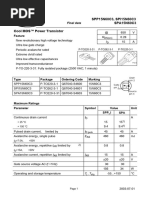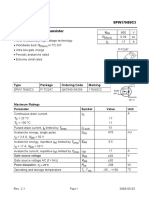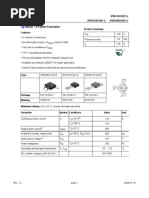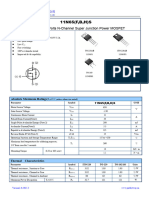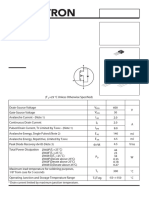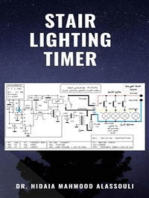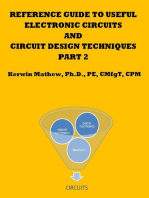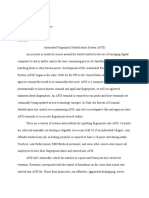Power Transistor: SPP11N60S5, SPB11N60S5 SPI11N60S5 Cool MOS™
Power Transistor: SPP11N60S5, SPB11N60S5 SPI11N60S5 Cool MOS™
Uploaded by
Abo AdamCopyright:
Available Formats
Power Transistor: SPP11N60S5, SPB11N60S5 SPI11N60S5 Cool MOS™
Power Transistor: SPP11N60S5, SPB11N60S5 SPI11N60S5 Cool MOS™
Uploaded by
Abo AdamOriginal Title
Copyright
Available Formats
Share this document
Did you find this document useful?
Is this content inappropriate?
Copyright:
Available Formats
Power Transistor: SPP11N60S5, SPB11N60S5 SPI11N60S5 Cool MOS™
Power Transistor: SPP11N60S5, SPB11N60S5 SPI11N60S5 Cool MOS™
Uploaded by
Abo AdamCopyright:
Available Formats
SPP11N60S5, SPB11N60S5
SPI11N60S5
Cool MOS™ Power Transistor VDS 600 V
www.datasheet4u.com
Feature RDS(on) 0.38 Ω
• New revolutionary high voltage technology ID 11 A
• Ultra low gate charge
• Periodic avalanche rated P-TO262 P-TO263-3-2 P-TO220-3-1
• Extreme dv/dt rated 2
• Ultra low effective capacitances 23
1
• Improved transconductance P-TO220-3-1
Type Package Ordering Code Marking
SPP11N60S5 P-TO220-3-1 Q67040-S4198 11N60S5
SPB11N60S5 P-TO263-3-2 Q67040-S4199 11N60S5
SPI11N60S5 P-TO262 Q67040-S4338 11N60S5
Maximum Ratings
Parameter Symbol Value Unit
Continuous drain current ID A
TC = 25 °C 11
TC = 100 °C 7
Pulsed drain current, tp limited by Tjmax I D puls 22
Avalanche energy, single pulse EAS 340 mJ
I D = 5.5 A, VDD = 50 V
Avalanche energy, repetitive tAR limited by Tjmax1) EAR 0.6
I D = 11 A, VDD = 50 V
Avalanche current, repetitive tAR limited by Tjmax I AR 11 A
Gate source voltage VGS ±20 V
Gate source voltage AC (f >1Hz) VGS ±30
Power dissipation, T C = 25°C Ptot 125 W
Operating and storage temperature T j , T stg -55... +150 °C
Rev. 2.1 Page 1 2004-03-30
SPP11N60S5, SPB11N60S5
SPI11N60S5
Maximum Ratings
www.datasheet4u.com
Parameter Symbol Value Unit
Drain Source voltage slope dv/dt 20 V/ns
V DS = 480 V, ID = 11 A, Tj = 125 °C
Thermal Characteristics
Parameter Symbol Values Unit
min. typ. max.
Thermal resistance, junction - case RthJC - - 1 K/W
Thermal resistance, junction - ambient, leaded RthJA - - 62
SMD version, device on PCB: RthJA
@ min. footprint - - 62
@ 6 cm2 cooling area 2) - 35 -
Soldering temperature, Tsold - - 260 °C
1.6 mm (0.063 in.) from case for 10s
Electrical Characteristics, at Tj=25°C unless otherwise specified
Parameter Symbol Conditions Values Unit
min. typ. max.
Drain-source breakdown voltage V(BR)DSS V GS=0V, ID=0.25mA 600 - - V
Drain-Source avalanche V(BR)DS V GS=0V, ID=11A - 700 -
breakdown voltage
Gate threshold voltage VGS(th) ID=500µΑ, VGS=V DS 3.5 4.5 5.5
Zero gate voltage drain current I DSS V DS=600V, VGS=0V, µA
Tj=25°C, - - 25
Tj=150°C - - 250
Gate-source leakage current I GSS V GS=20V, VDS=0V - - 100 nA
Drain-source on-state resistance RDS(on) V GS=10V, ID=7A, Ω
Tj=25°C - 0.34 0.38
Tj=150°C - 0.92 -
Gate input resistance RG f=1MHz, open Drain - 29 -
Rev. 2.1 Page 2 2004-03-30
SPP11N60S5, SPB11N60S5
SPI11N60S5
Electrical Characteristics , at Tj = 25 °C, unless otherwise specified
Parameter
www.datasheet4u.com
Symbol Conditions Values Unit
min. typ. max.
Characteristics
Transconductance g fs V DS≥2*I D*RDS(on)max, - 6 - S
ID=7A
Input capacitance Ciss V GS=0V, V DS=25V, - 1460 - pF
Output capacitance Coss f=1MHz - 610 -
Reverse transfer capacitance Crss - 21 -
Effective output capacitance,3) Co(er) V GS=0V, - 45 - pF
energy related V DS=0V to 480V
Effective output capacitance,4) Co(tr) - 85 -
time related
Turn-on delay time t d(on) V DD=350V, V GS=0/10V, - 130 - ns
Rise time tr ID=11A, R G=6.8Ω - 35 -
Turn-off delay time t d(off) - 150 225
Fall time tf - 20 30
Gate Charge Characteristics
Gate to source charge Qgs VDD=350V, ID=11A - 10.5 - nC
Gate to drain charge Qgd - 24 -
Gate charge total Qg VDD=350V, ID=11A, - 41.5 54
VGS=0 to 10V
Gate plateau voltage V(plateau) VDD=350V, ID=11A - 8 - V
1Repetitve avalanche causes additional power losses that can be calculated as P =EAR*f.
AV
2Device on 40mm*40mm*1.5mm epoxy PCB FR4 with 6cm² (one layer, 70 µm thick) copper area for drain
connection. PCB is vertical without blown air.
3C is a fixed capacitance that gives the same stored energy as Coss while VDS is rising from 0 to 80% V
o(er) DSS.
4C o(tr) is a fixed capacitance that gives the same charging time as Coss while VDS is rising from 0 to 80% VDSS.
Rev. 2.1 Page 3 2004-03-30
SPP11N60S5, SPB11N60S5
SPI11N60S5
Electrical Characteristics, at Tj = 25 °C, unless otherwise specified
www.datasheet4u.com
Parameter Symbol Conditions Values Unit
min. typ. max.
Inverse diode continuous IS TC=25°C - - 11 A
forward current
Inverse diode direct current, ISM - - 22
pulsed
Inverse diode forward voltage VSD VGS=0V, IF=IS - 1 1.2 V
Reverse recovery time trr VR=350V, IF =IS , - 650 1105 ns
Reverse recovery charge Qrr diF/dt=100A/µs - 7.9 - µC
Typical Transient Thermal Characteristics
Symbol Value Unit Symbol Value Unit
typ. typ.
Thermal resistance Thermal capacitance
R th1 0.015 K/W Cth1 0.0001878 Ws/K
R th2 0.03 Cth2 0.0007106
R th3 0.056 Cth3 0.000988
R th4 0.197 Cth4 0.002791
R th5 0.216 Cth5 0.007285
R th6 0.083 Cth6 0.063
Tj E xternal H eatsink
R th1 R th,n T case
P tot (t)
C th1 C th2 C th,n
T am b
Rev. 2.1 Page 4 2004-03-30
SPP11N60S5, SPB11N60S5
SPI11N60S5
1 Power dissipation 2 Safe operating area
Ptot = f (TC)
www.datasheet4u.com
ID = f ( V DS )
parameter : D = 0 , T C=25°C
SPP11N60S5 10 2
140
W
A
120
110
10 1
100
Ptot
90
ID
80
70 10 0
60
50 tp = 0.001 ms
40 tp = 0.01 ms
10 -1 tp = 0.1 ms
30 tp = 1 ms
20
DC
10
0 10 -2 0 1 2 3
0 20 40 60 80 100 120 °C 160 10 10 10 V 10
TC VDS
3 Transient thermal impedance 4 Typ. output characteristic
ZthJC = f (t p) ID = f (VDS); Tj=25°C
parameter: D = tp/T parameter: tp = 10 µs, VGS
1
10 35
K/W 20V
12V
A 10V
10 0
25
ZthJC
ID
10 -1 9V
20
D = 0.5
15
10 -2 D = 0.2
D = 0.1 8V
D = 0.05
D = 0.02 10
10 -3 D = 0.01
single pulse 7V
5
6V
10 -4 -7 -6 -5 -4 -3 -1 0
10 10 10 10 10 s 10 0 5 10 15 VDS 25
tp V
Rev. 2.1 Page 5 2004-03-30
SPP11N60S5, SPB11N60S5
SPI11N60S5
5 Typ. output characteristic 6 Typ. drain-source on resistance
ID = f (VDS); Tj=150°C
www.datasheet4u.com
RDS(on)=f(ID)
parameter: tp = 10 µs, VGS parameter: Tj=150°C, V GS
18 2
A 20V
12V
10V 9V
14 mΩ
RDS(on)
8V
12
ID
10
20V
1
12V
8 10V
7V 9V
6 8V
7V
0.5 6V
4
6V
0 0
0 5 10 15 V 25 0 2 4 6 8 10 12 14 A 18
VDS ID
7 Drain-source on-state resistance 8 Typ. transfer characteristics
RDS(on) = f (Tj) ID= f ( VGS ); V DS≥ 2 x ID x RDS(on)max
parameter : ID = 7 A, VGS = 10 V parameter: tp = 10 µs
SPP11N60S5
2.1 32
Ω
A
1.8
1.6 24
RDS(on)
1.4
ID
20 25 °C
1.2 150 °C
16
1
0.8 12
0.6
98% 8
0.4 typ
4
0.2
0 0
-60 -20 20 60 100 °C 180 0 4 8 12 V 20
Tj VGS
Rev. 2.1 Page 6 2004-03-30
SPP11N60S5, SPB11N60S5
SPI11N60S5
9 Typ. gate charge 10 Forward characteristics of body diode
VGS = f (QGate)
www.datasheet4u.com
IF = f (VSD)
parameter: ID = 11 A pulsed parameter: Tj , tp = 10 µs
16
SPP11N60S5
10 2 SPP11N60S5
V
A
0.2 VDS max
12 0.8 VDS max
10 1
VGS
10
IF
8
6
10 0
Tj = 25 °C typ
4
Tj = 150 °C typ
Tj = 25 °C (98%)
2 Tj = 150 °C (98%)
0 10 -1
0 10 20 30 40 50 nC 65 0 0.4 0.8 1.2 1.6 2 2.4 V 3
QGate VSD
11 Avalanche SOA 12 Avalanche energy
IAR = f (tAR) EAS = f (Tj)
par.: Tj ≤ 150 °C par.: ID = 5.5 A, V DD = 50 V
11 350
A
mJ
9
8 250
EAS
IAR
7
200
6
5 Tj (START) =25°C
150
4
3 Tj (START) =125°C
100
2
50
1
0 -3 -2 -1 0 1 2 4 0
10 10 10 10 10 10 µs 10 20 40 60 80 100 120 °C 160
tAR Tj
Rev. 2.1 Page 7 2004-03-30
SPP11N60S5, SPB11N60S5
SPI11N60S5
13 Drain-source breakdown voltage 14 Avalanche power losses
V(BR)DSS = f (Tj)
www.datasheet4u.com
PAR = f (f )
parameter: E AR=0.6mJ
SPP11N60S5
720 300
V
W
680
V(BR)DSS
PAR
660 200
640
150
620
600 100
580
50
560
540 0 4 5 6
-60 -20 20 60 100 °C 180 10 10 Hz 10
Tj f
15 Typ. capacitances 16 Typ. Coss stored energy
C = f (VDS) Eoss=f(VDS)
parameter: V GS=0V, f=1 MHz
10 4
7.5
µJ
pF
Ciss
6
10 3
5.5
Eoss
5
C
4.5
4
10 2
Coss
3.5
3
2.5
1 2
10 Crss
1.5
1
0.5
10 0 0
0 100 200 300 400 V 600 0 100 200 300 400 V 600
VDS VDS
Rev. 2.1 Page 8 2004-03-30
SPP11N60S5, SPB11N60S5
SPI11N60S5
www.datasheet4u.com
Definition of diodes switching characteristics
Rev. 2.1 Page 9 2004-03-30
SPP11N60S5, SPB11N60S5
SPI11N60S5
P-TO-220-3-1
www.datasheet4u.com
B
10 ±0.4 4.44
A
3.7 ±0.2 1.27±0.13
2.8 ±0.2
15.38 ±0.6
0.05
9.98 ±0.48
13.5 ±0.5
5.23 ±0.9
0.5 ±0.1
3x
0.75 ±0.1 2.51±0.2
1.17 ±0.22
2x 2.54
0.25 M A B C
All metal surfaces tin plated, except area of cut.
Metal surface min. x=7.25, y=12.3
P-TO-263-3-2 (D 2-PAK)
Rev. 2.1 Page 10 2004-03-30
SPP11N60S5, SPB11N60S5
SPI11N60S5
P-TO-262-3-1 (I2-PAK)
www.datasheet4u.com
10 ±0.2
A B
0...0.3 4.4
1)
8.5 1 ±0.3 1.27
0.05
1)
9.25 ±0.2
11.6 ±0.3
7.55
2.4
13.5 ±0.5
4.55 ±0.2
0...0.15 0.5 ±0.1
1.05 2.4
3 x 0.75 ±0.1
2 x 2.54
0.25 M A B C
1)
Typical
Metal surface min. X = 7.25, Y = 6.9
All metal surfaces tin plated, except area of cut.
Rev. 2.1 Page 11 2004-03-30
SPP11N60S5, SPB11N60S5
SPI11N60S5
Published by
www.datasheet4u.com
Infineon Technologies AG,
Bereichs Kommunikation
St.-Martin-Strasse 53,
D-81541 München
© Infineon Technologies AG 1999
All Rights Reserved.
Attention please!
The information herein is given to describe certain components and shall not be considered as warranted
characteristics.
Terms of delivery and rights to technical change reserved.
We hereby disclaim any and all warranties, including but not limited to warranties of non-infringement,
regarding circuits, descriptions and charts stated herein.
Infineon Technologies is an approved CECC manufacturer.
Information
For further information on technology, delivery terms and conditions and prices please contact your nearest
Infineon Technologies Office in Germany or our Infineon Technologies Reprensatives worldwide (see address list).
Warnings
Due to technical requirements components may contain dangerous substances.
For information on the types in question please contact your nearest Infineon Technologies Office.
Infineon Technologies Components may only be used in life-support devices or systems with the express
written approval of Infineon Technologies, if a failure of such components can reasonably be expected to
cause the failure of that life-support device or system, or to affect the safety or effectiveness of that device
or system Life support devices or systems are intended to be implanted in the human body, or to support
and/or maintain and sustain and/or protect human life. If they fail, it is reasonable to assume that the health
of the user or other persons may be endangered.
Rev. 2.1 Page 12 2004-03-30
You might also like
- Lto7 HH Service ManualDocument154 pagesLto7 HH Service Manualtiir100% (1)
- Infineon SPP - I11N60S5 DS v02 - 07 en 522948Document13 pagesInfineon SPP - I11N60S5 DS v02 - 07 en 522948rrebollarNo ratings yet
- Power Transistor: SPP07N60S5 SPI07N60S5 Cool MOS™Document12 pagesPower Transistor: SPP07N60S5 SPI07N60S5 Cool MOS™marce822No ratings yet
- SPP11N60C3 SPI11N60C3, SPA11N60C3 Cool MOS™ Power TransistorDocument15 pagesSPP11N60C3 SPI11N60C3, SPA11N60C3 Cool MOS™ Power TransistorWilliam JimenezNo ratings yet
- SPP11N60C3, SPB11N60C3 SPI11N60C3, SPA11N60C3 Cool MOS™ Power TransistorDocument15 pagesSPP11N60C3, SPB11N60C3 SPI11N60C3, SPA11N60C3 Cool MOS™ Power TransistorOzkar MorenoNo ratings yet
- SPP11N60C2, SPB11N60C2 SPA11N60C2 Cool MOS™ Power TransistorDocument15 pagesSPP11N60C2, SPB11N60C2 SPA11N60C2 Cool MOS™ Power TransistorCarlos Ruiz DiazNo ratings yet
- SPP11N60C2, SPB11N60C2 SPA11N60C2 Cool MOS™ Power TransistorDocument14 pagesSPP11N60C2, SPB11N60C2 SPA11N60C2 Cool MOS™ Power TransistorNivaldo OliveiraNo ratings yet
- Infineon SPP - I - A15N60C3 DS v03 - 03 EN 53478Document15 pagesInfineon SPP - I - A15N60C3 DS v03 - 03 EN 53478Jeferson TorresNo ratings yet
- 11N80C3Document13 pages11N80C3paulopeixotocostaNo ratings yet
- Power Transistor: SPP03N60S5 SPB03N60S5 Cool MOS™Document11 pagesPower Transistor: SPP03N60S5 SPB03N60S5 Cool MOS™VolodiyaNo ratings yet
- Infineon SPP A I11N65C3 DS v02 91 enDocument15 pagesInfineon SPP A I11N65C3 DS v02 91 enKhan AzadNo ratings yet
- Infineon SPW32N50C3 DS v02 - 05 en PDFDocument12 pagesInfineon SPW32N50C3 DS v02 - 05 en PDFHưng HQNo ratings yet
- Spa SPB SPP 04N60C3Document15 pagesSpa SPB SPP 04N60C3carl.daviesNo ratings yet
- 5N60C Power TransistorDocument13 pages5N60C Power TransistorTarcisio CoelhoNo ratings yet
- Coolmos Power Transistor: Features Product SummaryDocument10 pagesCoolmos Power Transistor: Features Product SummarybagusandrikNo ratings yet
- Coolmos Power Transistor: Features Product SummaryDocument10 pagesCoolmos Power Transistor: Features Product Summarysaom09No ratings yet
- Mosfet Tarjeta Ln25Document13 pagesMosfet Tarjeta Ln25JIRMAN ALEXANDER RODRIGUEZNo ratings yet
- Mosfet SPW20N60S5 PDFDocument12 pagesMosfet SPW20N60S5 PDFCarlos RobertoNo ratings yet
- 5 R 140 PDocument10 pages5 R 140 PAnkurNo ratings yet
- 32N50C3 Mos PDFDocument11 pages32N50C3 Mos PDFHưng HQNo ratings yet
- Infineon SPD - U03N60S5 DS v02 - 05 enDocument11 pagesInfineon SPD - U03N60S5 DS v02 - 05 enValentin BaNo ratings yet
- SPW 17 N 80Document12 pagesSPW 17 N 80Luis De los SantosNo ratings yet
- Coolmos Power Transistor: Features Product SummaryDocument11 pagesCoolmos Power Transistor: Features Product SummaryrobssonmcNo ratings yet
- 07N65C3 InfineonDocument15 pages07N65C3 Infineonjaviblas1No ratings yet
- SPP 17N80C3Document10 pagesSPP 17N80C3isaiasvaNo ratings yet
- Ipa90r500c3 - 1.0 Mosfet TransistorDocument10 pagesIpa90r500c3 - 1.0 Mosfet TransistorWilinton PissoNo ratings yet
- Infineon SPP17N80C3 DS v02 91 EnDocument10 pagesInfineon SPP17N80C3 DS v02 91 Ensb194628No ratings yet
- Coolmos Power Transistor: Features Product SummaryDocument10 pagesCoolmos Power Transistor: Features Product SummaryLuis Aguirre CaballeroNo ratings yet
- SPW20N60S5Document11 pagesSPW20N60S5Keys SyekNo ratings yet
- 15N65C3 Infineon TechnologiesDocument10 pages15N65C3 Infineon TechnologiesAmanNo ratings yet
- Coolmos Power Transistor: Features Product SummaryDocument10 pagesCoolmos Power Transistor: Features Product SummaryFélix NicolauNo ratings yet
- Ipp90r500c3 Semiconductor 900VDocument10 pagesIpp90r500c3 Semiconductor 900VtecnicospecNo ratings yet
- Please Note The New Package Dimensions Arccording To PCN 2009-134-ADocument11 pagesPlease Note The New Package Dimensions Arccording To PCN 2009-134-Aالكترونيات يافاNo ratings yet
- Power Transistor: Cool MOS™Document9 pagesPower Transistor: Cool MOS™Juan Carlos Anguiano NegreteNo ratings yet
- Dsa 00324548Document10 pagesDsa 00324548Herman Girius FonkouaNo ratings yet
- Coolmos Power Transistor: Features Product SummaryDocument10 pagesCoolmos Power Transistor: Features Product Summarysunil beedasseeNo ratings yet
- 16N50Document6 pages16N50Fábio Vitor MartinsNo ratings yet
- Power Transistor: Cool MOS™Document9 pagesPower Transistor: Cool MOS™DanNo ratings yet
- SPD04N80C3 Cool MOS™ Power Transistor: FeatureDocument11 pagesSPD04N80C3 Cool MOS™ Power Transistor: FeatureOliveira OliveiraNo ratings yet
- Infineon IPB160N04S2 - 03 DS v01 - 00 enDocument8 pagesInfineon IPB160N04S2 - 03 DS v01 - 00 enMuhammad Januar SusantoNo ratings yet
- Infineon SPP04N80C3 DS v02 91 enDocument10 pagesInfineon SPP04N80C3 DS v02 91 entombeanNo ratings yet
- Siemdat PDFDocument8 pagesSiemdat PDFNathan VeRaNo ratings yet
- KIA KIA KIA: 1.descriptionDocument5 pagesKIA KIA KIA: 1.descriptionzakreaNo ratings yet
- MOS 3 Power-Transistor: Features Product SummaryDocument11 pagesMOS 3 Power-Transistor: Features Product SummaryDeepak KamalNo ratings yet
- 11N65S PingweiDocument8 pages11N65S PingweiBall SVNo ratings yet
- (200V, 110A) IPP110N20NA - IPB107N20NA DS v02 - 01 enDocument10 pages(200V, 110A) IPP110N20NA - IPB107N20NA DS v02 - 01 enbillylu06No ratings yet
- Datasheet MOSFET 2N60Document2 pagesDatasheet MOSFET 2N60Alvina Victorina Lopes GomesNo ratings yet
- Coolmos Power Transistor: Features Product SummaryDocument10 pagesCoolmos Power Transistor: Features Product SummaryHeeranand ChandwaniNo ratings yet
- 07N60C3 InfineonDocument13 pages07N60C3 Infineoncesar meriñoNo ratings yet
- 6A MPS, 600 Volts N-CHANNEL MOSFET: FeatureDocument2 pages6A MPS, 600 Volts N-CHANNEL MOSFET: FeatureJose VelasquezNo ratings yet
- Unisonic Technologies Co., LTD: 60A, 60V N-Channel Power MosfetDocument8 pagesUnisonic Technologies Co., LTD: 60A, 60V N-Channel Power MosfetCyril ZachariasNo ratings yet
- SSP20N60S5Document9 pagesSSP20N60S5Milton AlvesNo ratings yet
- Shenzhen Tuofeng Semiconductor Technology Co., LTD: Product Summary FeatureDocument8 pagesShenzhen Tuofeng Semiconductor Technology Co., LTD: Product Summary Featurebuba.kastorsNo ratings yet
- 2n60p_2n60f_2n60i_2n60dDocument9 pages2n60p_2n60f_2n60i_2n60ddadiwahyudin3No ratings yet
- STK0765BF: Switching Regulator Applications FeaturesDocument8 pagesSTK0765BF: Switching Regulator Applications Featuresmaksyd2No ratings yet
- STK0765BF: Switching Regulator Applications FeaturesDocument8 pagesSTK0765BF: Switching Regulator Applications FeaturesHumberto AguilarNo ratings yet
- SPP08P06P SPB08P06P: Features Product SummaryDocument8 pagesSPP08P06P SPB08P06P: Features Product SummaryСтефан ТасиќNo ratings yet
- 08P06PDocument8 pages08P06PferlopezahqNo ratings yet
- Reference Guide To Useful Electronic Circuits And Circuit Design Techniques - Part 2From EverandReference Guide To Useful Electronic Circuits And Circuit Design Techniques - Part 2No ratings yet
- Essay 2Document3 pagesEssay 2api-486417302No ratings yet
- Visual Scripting GuideDocument145 pagesVisual Scripting Guideblevblayne92No ratings yet
- Test Blanc CorrectionDocument4 pagesTest Blanc CorrectionOmar Ben OmraneNo ratings yet
- Esteem PresentationDocument68 pagesEsteem PresentationmonugeniNo ratings yet
- SadDocument11 pagesSadBibash AdhikariNo ratings yet
- PRMG 010 - IntroductionDocument13 pagesPRMG 010 - IntroductionMena Amir KhairyNo ratings yet
- Ramya Kolluru Phone: (314) 384-2261Document6 pagesRamya Kolluru Phone: (314) 384-2261Kritika Shukla100% (1)
- Automated Graphs MakingDocument26 pagesAutomated Graphs MakingputanowrNo ratings yet
- Heat Pump Mirai Split Technical Sheet GB01Document28 pagesHeat Pump Mirai Split Technical Sheet GB01sabit1965No ratings yet
- Lec 2 Risk Assessment BDocument25 pagesLec 2 Risk Assessment BAffan KhawajaNo ratings yet
- Sandeep Modi: Professional SummaryDocument2 pagesSandeep Modi: Professional SummaryModi SandeepNo ratings yet
- Rotating Equipment Services in Indonesia E10819 en WebDocument6 pagesRotating Equipment Services in Indonesia E10819 en WebPEMELIHARAAN WLINGINo ratings yet
- Mercedes Benz Tools CatalogDocument5 pagesMercedes Benz Tools Cataloglisa98% (58)
- Manual IntellinetDocument28 pagesManual IntellinetXiime M. MartiinezNo ratings yet
- Solar Energy PQ AnalysisDocument5 pagesSolar Energy PQ AnalysisABHINAV SAURAVNo ratings yet
- 3-Routing in Packet Switched NetworksDocument58 pages3-Routing in Packet Switched NetworksAbhishek Kumar SinghNo ratings yet
- Active Power Filter: Project Guide: Prof. P.M. MeshramDocument21 pagesActive Power Filter: Project Guide: Prof. P.M. MeshramSumit SinghNo ratings yet
- Rynse Car Wash Identification GuideDocument18 pagesRynse Car Wash Identification GuideCate AlcantaraNo ratings yet
- 30 Examples of Personal AnalysisDocument1 page30 Examples of Personal AnalysisLuis AliagaNo ratings yet
- 3GPP TS 24.008Document666 pages3GPP TS 24.008ajjulteNo ratings yet
- Instructions : Form Downloaded From Https //automart - PH - Buy Your Quality Used Car From AutomartDocument3 pagesInstructions : Form Downloaded From Https //automart - PH - Buy Your Quality Used Car From AutomartJohn maronne De guzmanNo ratings yet
- DLP 1 - Media Information L1teracyDocument3 pagesDLP 1 - Media Information L1teracyArt Dollosa100% (1)
- Sparkfun Electronics Attiny85 Arduino Quick Reference Sheet: Structure Digital I/O Attiny85 PinsDocument1 pageSparkfun Electronics Attiny85 Arduino Quick Reference Sheet: Structure Digital I/O Attiny85 PinsAriance ProjectNo ratings yet
- Modeling Interference For Wireless Sensor Network SimulatorsDocument6 pagesModeling Interference For Wireless Sensor Network SimulatorsBee MUNo ratings yet
- New Text DocumentDocument8 pagesNew Text DocumentPratham RaiNo ratings yet
- bms.0910 r0 Monitoring Measurement Analysis Evaluation PDFDocument3 pagesbms.0910 r0 Monitoring Measurement Analysis Evaluation PDFYahia Mustafa AlfazaziNo ratings yet
- Fortens® H1.6-1.8FT, H2.0FTS (F001) : 1598527 ©2014 Hyster Company 06/2014Document998 pagesFortens® H1.6-1.8FT, H2.0FTS (F001) : 1598527 ©2014 Hyster Company 06/2014João VitorNo ratings yet
- LCD TV: Service ManualDocument31 pagesLCD TV: Service ManualJenica RadulescuNo ratings yet
- Practical No 9Document7 pagesPractical No 9Aakash ChaudhariNo ratings yet













